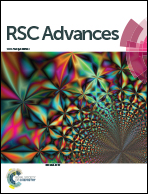POSS-based luminescent porous polymers for carbon dioxide sorption and nitroaromatic explosives detection†
Abstract
Luminescent hybrid porous polymers (LHPPs) have been synthesized by the Heck coupling reactions of cubic octavinylsilsequioxane (OVS) and halogenated triphenylamine (TPA). The resulting materials show high thermal stability, and their porous and luminescent properties could be tuned by altering TPA species and reaction condition. The optimized polymer LHPP-3 exhibits high porosity with a Brunauer–Emmett–Teller surface area of 680 m2 g−1 and total pore volume of 0.41 cm3 g−1, and emits high yellow luminescence. LHPP-3 possesses a moderate CO2 uptake of 1.44 mmol g−1 at 273 K and 0.77 mmol g−1 at 298 K at 1.01 bar, suggesting these polymers could be utilized as adsorbents for CO2 storage and capture. Significantly, the luminescence of LHPP-3 could be quenched efficiently by nitroaromatic explosives such as 4-nitrotoluene, 2,4-dinitrotoluene and 2,4,6-trinitrotoluene, thereby indicating that the polymers could be utilized as chemical sensors for explosives detection.


 Please wait while we load your content...
Please wait while we load your content...